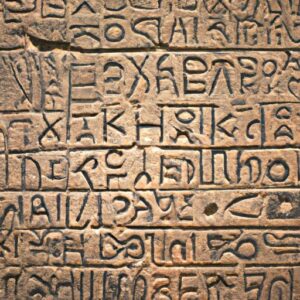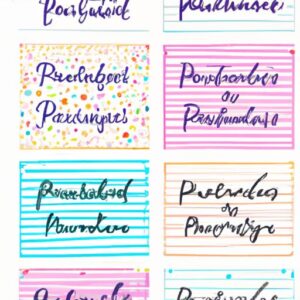In the world of graphic design, fonts play a crucial role in creating captivating visuals. Among the myriad of font options available, handwriting fonts have gained immense popularity for their ability to infuse elegance and personalization into designs. In this article, we will explore the importance of handwriting fonts in design and understand why they are widely favored by graphic designers.
A. Importance of Handwriting Fonts in Design
When it comes to design, every element should be carefully considered to create a lasting impression. Handwriting fonts offer a unique and distinct touch that sets designs apart from the crowd. These fonts evoke a sense of authenticity, mirroring the natural flow and imperfections found in human handwriting. By incorporating handwriting fonts, designers can add a personal and intimate feel to their creations, connecting with the audience on a deeper level.
Moreover, handwriting fonts enable designers to create a sense of nostalgia, harkening back to simpler times when handwritten letters were cherished. They bring warmth and character to designs, making them more relatable and engaging. Whether it’s a logo, website, or advertisement, handwriting fonts inject a dose of personality and charm, leaving a lasting impression on viewers.
B. Why Handwriting Fonts are Popular in Graphic Design
Graphic design is all about evoking emotions and telling stories through visuals. Handwriting fonts excel in this aspect by conveying a sense of individuality and human touch. In a world dominated by digital communication, handwriting fonts offer a refreshing break from the standardized, impersonal fonts commonly used online. They allow designers to create designs that are not only visually striking but also emotionally resonant.
Handwriting fonts also provide versatility, adapting well to various design styles and themes. Whether it’s a vintage-inspired design or a modern and minimalist layout, handwriting fonts can effortlessly complement and enhance the overall aesthetic. This adaptability contributes to the popularity of handwriting fonts, enabling designers to experiment and create unique designs that reflect the essence of their brand or project.
In conclusion, handwriting fonts have become a staple in graphic design due to their ability to add elegance, authenticity, and personalization to designs. By incorporating these fonts, designers can evoke emotions, connect with their audience, and create visually captivating designs that stand out from the crowd. As we delve deeper into this article, we will explore different types of handwriting fonts, their benefits, factors to consider when choosing them, and effective tips for utilizing them in design. So, let’s embark on this typographic journey together and uncover the beauty and power of handwriting fonts!
Types of Handwriting Fonts
In the realm of typography, handwriting fonts encompass a variety of styles that add a personal touch to designs. Let’s explore the different types of handwriting fonts and their unique characteristics.
A. Script Fonts
Script fonts emulate the fluid strokes of cursive handwriting, exuding elegance and sophistication. They are characterized by their flowing and interconnected letters, mimicking the natural movement of a pen. Script fonts are ideal for projects that require a touch of refinement and grace.
1. Characteristics of Script Fonts
Script fonts often feature elaborate loops, swashes, and flourishes that enhance their visual appeal. They can range from delicate and formal styles to more casual and playful variations. The varying thickness of strokes adds depth and dimension to the letterforms, creating a captivating visual rhythm.
2. Examples of Popular Script Fonts
-
Lobster: Known for its bold, curvaceous strokes, Lobster is a versatile script font suitable for a wide array of design projects. Its distinctive letterforms instantly capture attention and convey a sense of modern elegance.
-
Great Vibes: Great Vibes is a script font that exudes a classic and timeless charm. Its delicate, flowing strokes lend an air of sophistication to any design, making it a popular choice for wedding invitations and formal events.
B. Cursive Fonts
Cursive fonts, also known as handwriting fonts, imitate the fluidity and interconnectedness of handwritten script. They often resemble the style of handwriting taught in schools. Cursive fonts can evoke a sense of nostalgia and familiarity, making them a popular choice for various design projects.
1. Features of Cursive Fonts
Cursive fonts are characterized by their slanted and joined letterforms, replicating the natural flow of handwriting. They exhibit a sense of informality and convey a personal touch, making them ideal for designs that aim to create a friendly and approachable atmosphere.
2. Well-known Cursive Fonts in the Market
-
Brush Script: Brush Script is a widely recognized cursive font that mimics the strokes of a paintbrush. It exudes a sense of casual elegance and is often used in advertisements, book covers, and product packaging.
-
Snell Roundhand: Snell Roundhand is a classic cursive font that showcases a timeless and refined aesthetic. Its elegant letterforms make it suitable for formal occasions, such as event invitations or certificates.
C. Calligraphy Fonts
Calligraphy fonts emulate the art of decorative handwriting and are renowned for their graceful and intricate letterforms. They are often associated with luxury, prestige, and high-end designs.
1. Key Attributes of Calligraphy Fonts
Calligraphy fonts exhibit elaborate and ornate letterforms, resembling the craftsmanship of traditional calligraphy. They feature delicate lines, contrasting thick and thin strokes, and intricate details that exude a sense of artistry and opulence.
2. Noteworthy Calligraphy Fonts to Consider
-
Edwardian Script: Edwardian Script is a popular calligraphy font that combines elegance and readability. Its sweeping strokes and delicate curves make it suitable for formal occasions, such as wedding invitations or certificates.
-
Copperplate: Copperplate is a classic calligraphy font known for its refined and precise letterforms. Its balanced proportions and intricate details make it an excellent choice for luxury branding, typography art, and formal documents.
As we delve further into this article, we will explore the benefits of using handwriting fonts in design, factors to consider when choosing them, and effective tips for utilizing them effectively. So, let’s continue our typographic journey and uncover the beauty and versatility of handwriting fonts!
Benefits of Using Handwriting Fonts in Design
Incorporating handwriting fonts into design projects offers a multitude of benefits that go beyond mere aesthetics. Let’s delve into why these fonts are highly advantageous in creating visually appealing and engaging designs.
A. Enhanced Aesthetics and Personalization
1. How Handwriting Fonts Add a Unique Touch
Handwriting fonts possess a distinct charm that sets them apart from traditional fonts. Their irregularities, varying stroke widths, and imperfections lend an organic and authentic feel to designs. By using handwriting fonts, designers can infuse their creations with a unique touch, making them stand out from the crowd. Whether it’s a logo, invitation, or website, handwriting fonts add a touch of elegance and personalization that resonates with viewers.
2. Customization of Handwriting Fonts
One of the remarkable aspects of handwriting fonts is their versatility and customizability. Designers have the freedom to modify and customize these fonts to suit their specific needs and design requirements. With a plethora of available handwriting fonts and the ability to tweak various parameters such as letter spacing, baseline shifts, and ligatures, designers can create truly unique and tailor-made designs that align with their creative vision.
B. Improved Readability and Engagement
1. Impact of Handwriting Fonts on Readability
Contrary to popular belief, handwriting fonts can enhance readability when used appropriately. These fonts, when chosen wisely, can strike a balance between legibility and aesthetics. By carefully selecting handwriting fonts with clear letterforms and proper spacing, designers can ensure that the text remains easy to read, even in longer passages. This readability factor contributes to a seamless reading experience, keeping readers engaged and immersed in the design.
2. Captivating Readers with Handwriting Fonts
Handwriting fonts have the power to captivate readers and evoke emotions. The organic and human-like qualities of these fonts create a sense of familiarity and relatability. When used strategically, handwriting fonts can elicit an emotional response from the audience, establishing a connection and leaving a lasting impression. By infusing designs with the warmth and personality of handwriting fonts, designers can create designs that truly resonate with their target audience.
C. Expressing Brand Identity and Emotions
1. Establishing Brand Personality with Handwriting Fonts
A brand’s identity is crucial for establishing a strong presence and connecting with consumers. Handwriting fonts offer an excellent opportunity to express and reinforce a brand’s personality and values. By choosing handwriting fonts that align with a brand’s tone and character, designers can create a consistent and cohesive visual identity that leaves a lasting imprint on consumers’ minds. Handwriting fonts enable brands to communicate a sense of approachability, authenticity, and individuality, setting them apart from competitors.
2. Conveying Emotions through Handwriting Fonts
Designs are not merely visual; they also aim to convey emotions and messages. Handwriting fonts excel in conveying these emotions effectively. The unique characteristics and organic flow of handwriting fonts allow designers to evoke specific emotions that align with the design’s purpose. Whether it’s a playful and whimsical design or a heartfelt and sentimental message, handwriting fonts add an extra layer of emotional depth, making the design more impactful and memorable.
In the next section, we will explore the various factors designers should consider when choosing handwriting fonts to ensure the success of their design projects.
Factors to Consider When Choosing Handwriting Fonts
When it comes to choosing the perfect handwriting font for your design, several factors need to be taken into consideration. By carefully evaluating the context, legibility, and compatibility with digital platforms, you can ensure that your chosen handwriting font aligns seamlessly with your design goals. Let’s explore these essential factors in detail:
A. Context and Purpose of the Design
-
Suitability of Handwriting Fonts for Different Projects:
Before selecting a handwriting font, it’s crucial to assess whether it suits the project’s overall theme and purpose. Consider the tone, message, and target audience of your design. For example, a playful and whimsical handwriting font may be ideal for a children’s book cover, while a more elegant and refined font may be better suited for a formal invitation. -
Matching Fonts with Design Intentions:
Each design has its unique intentions and aesthetic requirements. Ensure that the handwriting font you choose aligns with your design intentions. Pay attention to factors such as the font’s style, stroke weight, and overall visual characteristics, ensuring they complement and enhance the overall design concept.
B. Legibility and Clarity
-
Ensuring Readability of Handwriting Fonts:
While handwriting fonts offer a distinct charm, it is essential to prioritize legibility. Ensure that the font is clear and easily readable, even at different sizes and resolutions. Consider the letterforms, spacing, and overall readability when selecting a handwriting font to ensure that the text remains easily comprehensible for the intended audience. -
Balancing Style and Legibility:
While legibility is crucial, it’s equally important to maintain the stylistic integrity of the handwriting font. Look for fonts that strike a balance between style and legibility, where the unique characteristics of the font shine through without compromising the ease of reading.
C. Compatibility with Digital Platforms
-
Optimizing Handwriting Fonts for Online Use:
In today’s digital age, it’s essential to consider how handwriting fonts will appear on various digital platforms. Optimize the font for web use by choosing a format compatible with different browsers and devices. Additionally, ensure that the font file size is reasonable to avoid long loading times on websites. -
Considering Screen Resolution and Scaling:
Different devices and screen resolutions can affect how handwriting fonts appear. Choose a font that retains its legibility and visual appeal across different screen sizes and resolutions. Test the font on various devices to ensure that it renders well and maintains its intended aesthetic, regardless of the viewing environment.
By taking into account the context, legibility, and compatibility with digital platforms, you can make an informed decision when choosing a handwriting font for your design. The next section will provide valuable tips on utilizing handwriting fonts effectively, allowing you to create visually captivating designs that leave a lasting impact. So, let’s continue our typographic journey!
Tips for Using Handwriting Fonts Effectively
When it comes to utilizing handwriting fonts in design, there are certain strategies that can enhance their impact and ensure a visually appealing result. Here are some valuable tips to help you make the most out of handwriting fonts and create designs that captivate your audience.
A. Pairing Handwriting Fonts with Complementary Typefaces
-
Contrast between Handwriting and Sans-serif Fonts: One effective approach is to pair handwriting fonts with sans-serif typefaces. The contrasting styles create a visually striking balance that draws attention to the handwritten elements while maintaining legibility and readability. The clean lines of a sans-serif font provide a modern and minimalistic backdrop that allows the handwriting font to shine.
-
Harmonious Combination of Handwriting Fonts with Serif Fonts: Another option is to combine handwriting fonts with serif typefaces. This pairing can create a harmonious and elegant design, especially when used in headings or for emphasizing specific elements. The contrast between the formal and structured serifs and the organic flow of the handwriting fonts adds depth and visual interest to the overall design.
B. Adjusting Font Sizes and Spacing
-
Finding the Right Balance for Headings and Body Text: It’s crucial to strike the right balance between font sizes for headings and body text. Handwriting fonts tend to have more intricate details, which may require a larger size to ensure legibility. Experiment with different sizes to find the perfect harmony between readability and visual appeal. Remember to consider the hierarchy of information and adjust the sizes accordingly.
-
Proper Spacing for Improved Readability: Pay attention to the spacing between letters and lines to enhance the readability of your design. Handwriting fonts often have unique letterforms and varying stroke widths that may require adjustments. Avoid overcrowding the text and aim for a comfortable reading experience. Adjusting the tracking and leading can significantly improve the overall legibility and aesthetics of your design.
C. Consistency in Font Usage
-
Maintaining Consistency throughout the Design: Consistency is key when using handwriting fonts. Stick to a consistent set of fonts within your design to create a unified and cohesive look. Avoid mixing too many different handwriting fonts as it can lead to visual clutter and confusion. Select a primary handwriting font and complement it with a few variations or weights for different purposes within your design.
-
Establishing a Cohesive Visual Identity: Handwriting fonts can help establish a unique visual identity for your brand or project. Consider using the same handwriting font across different mediums and platforms to create a recognizable and consistent brand presence. This consistency helps build trust and familiarity with your audience, reinforcing your brand’s message and values.
By following these tips, you can effectively utilize handwriting fonts in your designs, creating visually appealing and engaging compositions. Remember to experiment, stay consistent, and strike a balance between aesthetics and readability. With these strategies in mind, you’ll be able to harness the power of handwriting fonts to elevate your designs to new heights.
Conclusion
In the realm of graphic design, handwriting fonts have emerged as a powerful tool for adding a touch of elegance, authenticity, and personalization to designs. These fonts hold immense importance in creating visually captivating and emotionally resonant designs that leave a lasting impression on the audience.
By incorporating handwriting fonts, designers can infuse their creations with a unique and distinct touch that sets them apart from the crowd. The natural flow and imperfections found in human handwriting bring warmth and character to designs, creating a sense of intimacy and connection with the viewers. Handwriting fonts also evoke nostalgia, reminding us of simpler times when handwritten letters held a special place in our hearts.
The popularity of handwriting fonts in graphic design is driven by their ability to evoke emotions, tell stories, and convey a sense of individuality. In a digital era dominated by standardized and impersonal fonts, handwriting fonts offer a refreshing break. They provide a versatile option that can adapt to various design styles and themes, further enhancing the overall aesthetic.
When choosing handwriting fonts, designers must consider the context and purpose of the design, ensuring legibility, and compatibility with digital platforms. By effectively pairing handwriting fonts with complementary typefaces, adjusting font sizes and spacing, and maintaining consistency throughout the design, designers can unleash the full potential of these fonts.
In conclusion, handwriting fonts are an invaluable asset in graphic design, enabling designers to create visually striking, emotionally resonant, and captivating designs. As technology advances, the allure of handwriting fonts remains timeless, reminding us of the beauty and power of the human touch in design. So, embrace the elegance of handwriting fonts and let your designs speak volumes!





